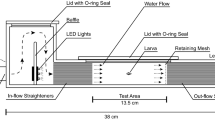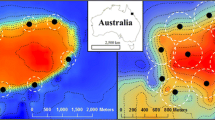Abstract
We examined the relationship between swimming performance, wave exposure, and the distribution patterns of labrids on temperate rocky reefs, in comparison with previous functional analyses of a tropical assemblage. Visual censuses of the distribution and abundance of labrids across two major gradients of wave exposure (depth and aspect to prevailing winds) were made at two offshore islands near Port Stephens, New South Wales, Australia. Distinct shifts in species composition and abundance were evident between high and low wave exposure habitats on temperate rocky reefs, particularly between deep and shallow habitats on exposed reef fronts. The swimming performances of temperate labrids were assessed through examination of pectoral fin shape (aspect ratio) and in situ swimming speeds. A diversity of pectoral fin morphologies was exhibited within this temperate assemblage, ranging from rounded to tapered fins (aspect ratios of 0.52 and 1.43, respectively). Fin shape was strongly correlated (Pearson’s correlation 0.884, P<0.001) with swimming speed (ranging from 1.05 and 3.06 body lengths s−1), in a relationship comparable to that observed in tropical labrids. Inter-specific differences in swimming ability provided some explanation for differences in the distribution and abundance of temperate labrids in relation to wave exposure. However, our findings suggest that although coral reef labrids appear to predominantly use high aspect-ratio fins to successfully occupy wave-exposed habitats, temperate labrids appear to be using an enhanced swimming ability through increased body size.








Similar content being viewed by others
References
Beamish FWH (1978) Swimming capacity. In: Hoar WS, Randall DJ (eds) Fish physiology, vol VII. Academic, New York, pp 101–187
Bellwood DR, Wainwright PC (2001) Locomotion in labrid fishes: implications for habitat use and cross-shelf biogeography on the Great Barrier Reef. Coral Reefs 20:139–150
Bellwood DR, Wainwright PC, Fulton CJ, Hoey A (2002) Assembly rules and functional groups at global biogeographical scales. Funct Ecol 16:557–562
Blake RW (1979) The mechanics of labriform locomotion. I. Labriform locomotion in the angelfish (Pterophyllum eimekei): an analysis of the power stroke. J Exp Biol 82:255–271
Bodkin JL, Van Blaricom GR, Jameson RJ (1987) Mortalities of kelp forest fishes associated with large oceanic waves off central California, 1982–1983. Environ Biol Fishes 18:73–76
Dennison WC, Barnes DJ (1988) Effect of water motion on coral photosynthesis and calcification. J Exp Mar Biol Ecol 115:67–77
Denny MW (1988) Biology and the mechanics of the wave-swept environment. Princeton University Press, Princeton
Denny MW (1994) Roles of hydrodynamics in the study of life on wave-swept shores. In: Wainwright PC, Reilly SM (eds) Ecological morphology: integrative organismal biology. University of Chicago Press, Chicago, pp 169–204
Denny M, Gaylord B (1996) Why the urchin lost its spines—hydrodynamic forces and survivorship in three echinoids. J Exp Biol 199:717–729
Done TJ (1983) Coral zonation: its nature and significance. In: Barnes DJ (ed) Perspectives on coral reefs. Clouston, Manuka, pp 107–147
Drucker EG, Jensen JS (1997) Kinematic and electromyographic analysis of steady pectoral fin swimming in the surfperches. J Exp Biol 200:1709–1723
Ebeling AW, Hixon MA (1991) Tropical and temperate reef fishes: comparison of community structures. In: Sale PF (ed) The ecology of fishes on coral reefs. Academic, Sydney, pp 509–563
Ebeling AW, Laur DR, Rowley RJ (1985) Severe storm disturbances and reversal of community structure in a southern California kelp forest. Mar Biol 84:287–294
Friedland MT, Denny MW (1995) Surviving hydrodynamic forces in a wave-swept environment: consequences of morphology in the feather boa kelp, Egregia menziesii (Turner). J Exp Mar Biol Ecol 190:109–133
Fulton CJ, Bellwood DR (2002) Ontogenetic habitat use in labrid fishes: an ecomorphological perspective. Mar Ecol Prog Ser 236:255–262
Fulton CJ, Bellwood DR, Wainwright PC (2001) The relationship between swimming ability and habitat use in wrasses (Labridae). Mar Biol 139:25–33
Gaylord B, Blanchette CA, Denny MW (1994) Mechanical consequences of size in wave-swept algae. Ecol Monogr 64:287–313
Green AL (1996) Spatial, temporal and ontogenetic patterns of habitat use by coral reef fishes (family Labridae). Mar Ecol Prog Ser 133:1–11
Lewis JR (1968) Water movements and their role in rocky shore ecology. Sarsia 34:13–36
McQuaid CD, Lindsay TL (2000) Effect of wave exposure on growth and mortality rates of the mussel Perna perna: bottom-up regulation of intertidal populations. Mar Ecol Prog Ser 206:147–154
Meekan MG, Choat JH (1997) Latitudinal variation in abundance of herbivorous fishes: a comparison of temperate and tropical reefs. Mar Biol 128:373–383
Sagnes P, Champagne JY, Morel R (2000) Shifts in drag and swimming potential during grayling ontogenesis: relations with habitat use. J Fish Biol 57:52–68
Schmidt-Nielsen K (1997) Animal physiology: adaptation and environment, 5th edn. Cambridge University Press, Cambridge
Shanks AL, Wright WG (1986) Adding teeth to wave action: the destructive effects of wave-borne rocks on intertidal organisms. Oecologia 69:420–428
Short AD, Trenaman NL (1992) Wave climate of the Sydney region, an energetic and highly variable ocean wave regime. Aust J Mar Freshw Res 43:765–791
Trussell GC (2002) Evidence of countergradient variation in the growth of an intertidal snail in response to water velocity. Mar Ecol Prog Ser 243:123–131
Vogel S (1994) Life in moving fluids: the physical biology of flow, 2nd edn. Princeton University Press, Princeton
Wainwright PC, Bellwood DR, Westneat MW (2002) Ecomorphology of locomotion in labrid fishes. Environ Biol Fishes 65:47–62
Walker JA, Westneat MW (2000) Mechanical performance of aquatic rowing and flying. Proc R Soc Lond Ser B Biol Sci 267:1875–1881
Walker JA, Westneat MW (2002) Performance limits of labriform propulsion and correlates with fin shape and motion. J Exp Biol 205:177–187
Wardle CS (1977) Effects of size on the swimming speeds of fish. In: Pedley TJ (ed) Scale effects in animal locomotion. Academic, London, pp 299–313
Webb PW (1994) The biology of fish swimming. In: Maddock L, Bone Q, Rayner JMV (eds) Mechanics and physiology of animal swimming. Cambridge University Press, Cambridge, pp 45–62
Young IR (1989) Wave transformation over coral reefs. J Geophys Res 94:9779–9789
Acknowledgements
We thank J. Ackerman, T. Fulton and A. Thomas for assistance in the field, and J. Simm for his generous contribution of time and logistical support in Port Stephens. We also thank J. Walker, P. Wainwright and M. Westneat for helpful discussions. Financial support was provided by the Australian Research Council and James Cook University. JCU Animal Experimentation Ethics approval no. A656-01. This is contribution no. 083 of the Centre for Coral Reef Biodiversity.
Author information
Authors and Affiliations
Corresponding author
Additional information
Communicated by G.F. Humphrey, Sydney
Rights and permissions
About this article
Cite this article
Fulton, C.J., Bellwood, D.R. Wave exposure, swimming performance, and the structure of tropical and temperate reef fish assemblages. Marine Biology 144, 429–437 (2004). https://doi.org/10.1007/s00227-003-1216-3
Received:
Accepted:
Published:
Issue Date:
DOI: https://doi.org/10.1007/s00227-003-1216-3




